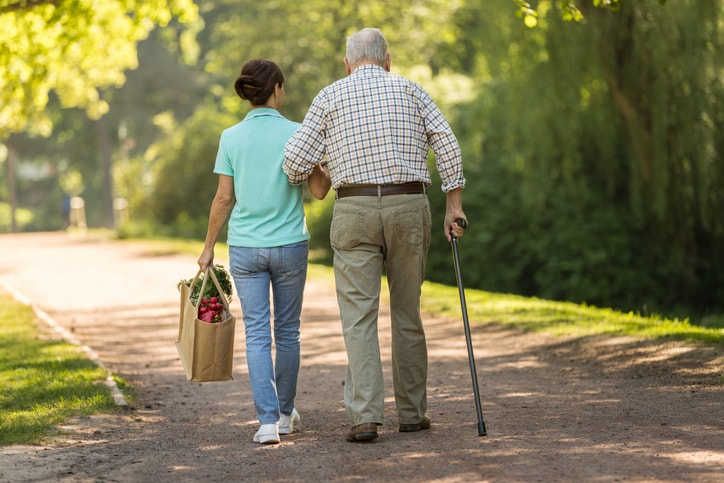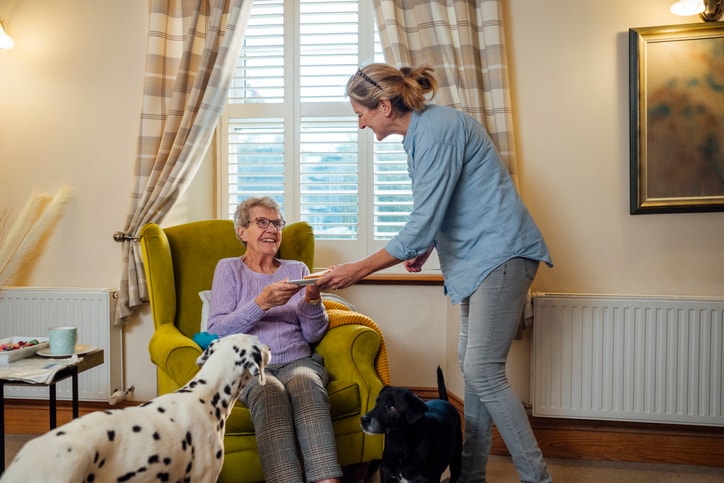It’s common to become less steady as we get older. “As people age, they often experience muscle weakness, joint issues and problems with their sense of balance,” explains Dr. Raj Dasgupta, a quadruple board-certified physician and chief medical advisor for Garage Gym Reviews.
But while some amount of unsteadiness is typical, it’s important to recognize that unsteadiness can also become a serious issue for seniors, with potentially dangerous impacts. In particular, unsteadiness can increase the chances of falling. Falls are a leading cause of serious injury and even death in people ages 65 and over.
Here, we’ll take a close look at what causes balance problems in seniors, the steps you can take to manage unsteadiness and how to ensure you or the senior in your care stays safe.
What causes unsteadiness in older people?
Balance issues can impact anyone, but older people in particular tend to experience them. Often, there is more than one factor that causes unsteadiness in seniors. Jessica Corona-Irwin, registered nurse, certified dementia practitioner and support group facilitator at Remo Health, lists the following as some of the top causes of unsteadiness in seniors:
Muscle weakness
It’s common for muscles to become weaker with age, a condition called sarcopenia. Loss of muscle, especially in your legs and core, can affect balance, leading to unsteadiness, says Corona-Irwin.
“Focus on balance and strength training exercises, such as Tai Chi, yoga or a physical therapy program. [These] can help improve muscle strength, flexibility and coordination.”
— Jessica Corona-Irwin, registered nurse and certified dementia practitioner, Remo Health
Neurological conditions
Neurological conditions like Parkinson’s dementia and Alzheimer’s can “disrupt the brain’s ability to control coordination and spatial awareness,” Corona-Irwin shares. “Dementia, in particular, can impair judgment, leading to risky behaviors and difficulty navigating surroundings.”
Medications
Some medications commonly prescribed to seniors can impair balance and mobility. These include antipsychotics, benzodiazepines and anticholinergics, Corona-Irwin explains. “It’s essential to review all medications with a doctor to identify and manage these risks.”
Medical conditions impacting seniors
There are various medical conditions more common in seniors that can lead to balance issues and unsteadiness. For example, orthostatic hypotension, where you experience a significant drop in blood pressure upon standing up, can lead to dizziness and unsteadiness, according to Corona-Irwin. Additionally, “poorly managed diabetes can contribute to unsteadiness and falls,” she adds.
According to Dasgupta, other potential causes of balance problems in seniors may include:
- Inner ear issues.
- Joint pain and stiffness.
- Poor vision.
- Vertigo, which causes you to feel like the world around you is spinning.
- Low blood pressure.
- Dehydration.
- Stress.
- A problem in the brain, such as a stroke.
How to prevent loss of balance as you age
Thankfully, unsteadiness and falling don’t have to be inevitable. There are some precautions that all seniors can take to decrease unsteadiness and mitigate its negative impacts.
1. Strengthen your legs and core
Strengthening the body and doing balance exercises can help with unsteadiness and prevent falls. “Focus on balance and strength training exercises, such as Tai Chi, yoga or a physical therapy program,” says Corona-Irwin. Programs like these “can help improve muscle strength, flexibility and coordination.”
Read more:
2. Evaluate your footwear
You shouldn’t underestimate the power of proper footwear, says Corona-Irwin. “Older adults should wear well-fitting, supportive shoes with non-slip soles to enhance stability.”
3. Get regular vision and hearing checkups
You may not realize it, but vision and hearing also impact steadiness. “These senses play a critical role in maintaining balance,” Corona-Irwin explains. She suggests making sure to get regular vision and hearing screenings. “If an older adult wears glasses or hearing aids, make sure they are up-to-date and functioning correctly,” says Corona-Irwin.
4. Do a home safety assessment
Make sure your home is clear of hazards to prevent both unsteadiness and falling. This includes removing loose rugs, clutter and poor lighting, Corona-Irwin suggests. Easy changes, such as installing grab bars in the bathroom or using non-slip mats, can make a significant difference in preventing falls.
5. Do a medication review
Certain medications — or medication combinations — may cause unsteadiness in adults. Since many older adults take multiple medications, it’s vital that you go over your medication list periodically with your medical provider to identify any that may cause either dizziness or unsteadiness, Corona-Irwin recommends.
Common treatments for balance problems in seniors
If you or someone you care for is experiencing increasing or concerning unsteadiness, you should bring this up with their healthcare provider. They can help you decide what type of support is best for the situation. In general, “managing unsteadiness involves a comprehensive and multidisciplinary approach,” says Corona-Irwin. This usually includes supportive therapies and supportive devices, including:
Physical therapy
“A physical therapist can design a personalized exercise program to improve strength, flexibility and balance,” Corona-Irwin shares. “These exercises are tailored to the individual’s specific needs and can be adjusted as their condition changes.”
Occupational therapy
Occupational therapy is similar to physical therapy, but involves helping a senior learn adaptive strategies and use assistive devices to enhance safety and independence. “For example, they might suggest using a reacher to pick up items from the floor or a raised toilet seat to make bathroom use easier,” says Corona-Irwin.

Assistive devices
Older individuals often need assistive devices like walkers, canes or wheelchairs to help them if they are experiencing unsteadiness and to reduce the risk of falling. If your doctor has recommended one of these devices, it’s important to keep them nearby for easy access, Corona-Irwin recommends.
Regular medical check-ups
Your healthcare provider should be your go-to person for helping you identify and manage health conditions contributing to unsteadiness. “Conditions like inner ear disorders, neurological issues and chronic diseases can be monitored and treated to reduce their impact on mobility,” Corona-Irwin says.
What are the dangers of unsteadiness in older people?
While unsteadiness in seniors can feel like a fact of life, it’s not without consequences, especially when the unsteadiness is serious and not being monitored. Here’s what to know about the risks and dangers of unsteadiness in older adults.
Increased risk of falling
Falls are one of the most immediate and serious dangers of unsteadiness, says Corona-Irwin. “A fall can result in fractures, head trauma and soft tissue injuries, which can be particularly debilitating for older adults.”
Unfortunately, falling is very common, with about one in four adults ages 65 and up experiencing a fall each year. Falls in seniors lead to roughly three million emergency room visits each year.
“While mild unsteadiness is normal with aging, anything that’s interfering with daily activities or getting worse needs professional attention.”
— Dr. Raj Dasgupta, board-certified physician
Decreased quality of life
Beyond the risk of falling, unsteadiness can also lead to an overall decrease in quality of life, Corona-Irwin says. “Older adults may experience anxiety, depression and social isolation as a result of their balance issues. These emotional and psychological impacts can further exacerbate physical health problems, creating a vicious cycle.”
Not only that, but falls often require medical intervention, hospitalization and rehabilitation — all of which can be stressful and disruptive to both the senior and their caregivers.
The bottom line on loss of balance in seniors
Unsteadiness in older adults can be caused by many things, including muscle weakness, medications, neurological conditions and medical conditions. While unsteadiness is common in seniors, it shouldn’t be ignored. This is especially true if it’s impacting your day-to-day life.
“While mild unsteadiness is normal with aging, anything that’s interfering with daily activities or getting worse needs professional attention,” Dasgupta advises. He recommends reaching out to a healthcare provider if the unsteadiness is accompanied by dizziness, vision problems or headaches.
“Any sudden balance issues, especially after a fall, should be looked at right away,” Dasgupta emphasizes.





